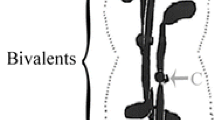Abstract
A technique for the fixation of cells during live observation (Nicklas et al. 1979) was used to investigate chromosomes which were moving at the time of fixation. Chromosome fibres were reconstructed by tracking their microtubules in longitudinal serial sections. A considerable proportion of non-kinetochoric microtubules (free microtubules, fMTs) is skewed with respect to the fibre axis. These skew fMTs contribute to the degree of disorder. It was found that the difference in the relative proportion of skew fMTs between “active” fibres (oriented in the direction of movement) and “passive” fibres (oriented backwards) is significantly correlated with the chromosome velocity (correlation coefficient r=0.796, P=0.01). It can be concluded that the pulling force generated in the chromosome fibre is a function of skew fMTs.
Similar content being viewed by others
References
Bajer AS, Mole-Bajer J (1969) Formation of spindle fibres, kinetochore orientation and behavior of the nuclear envelope during mitosis in endosperm. Chromosoma 27:448–484
Bajer AS (1973) Interaction of microtubules and the mechanism of chromosome movement (zipping hypothesis). 1. General principle. Cytobios 8:139–160
Bajer AS, Molè-Bajer J, Lambert AM (1975) Lateral interaction of microtubules and chromosome movements. In: Borges M, de Brabander M (eds) Microtubules and microtubules inhibitors. North-Holland Publishing Company, Amsterdam, pp 393–423
Bajer AS, Molè-Bajer J (1981) Mitosis: Studies of living cellsa revision of basic concepts. In: Mitosis/Cytokinesis. Academic Press, New York, pp 277–299
Bauer H, Dietz R, Roebbelen C (1961) Die Spermatocytenteilung der Tupuliden. III. Das Bewegungsverhalten der Chromosomen in Translokationszygoten von Tipula oleracea. Chromosoma 12:112–189
Begg DA, Ellis GW (1979) Micromanipulation studies of chromosome movement: I. Chromosome-spindle attachment and the mechanical properties of chromosomal spindle fibres. J Cell Biol 82:528–541
Church K, Lin HPP (1985) Kinetochore microtubules and chromosome movement during prometaphase in Drosophila melanogaster spermatocytes studied in life and with electron microscope. Chromosoma 92:273–282
Dietrich J (1979) Reconstructions tridimensionnelles de l'appareil mitotique a partir de coupes seriees longitudinales de meiocytes polliniques. Biol Cell 34:77–82
Dietz R (1956) Die Spermatocytenteilung der Tipuliden. II. Graphische Analyse der Chromosomenbewegung während der Prometaphase. Chromosoma 8:183–211
Dietz R (1969) Bau und Funktion des Spindelapparates. Naturwissenschaften 56:237–248
Fuge H (1975) Anaphase transport of akinetochoric fragments in tipulid spermatocytes. Chromosoma 52:149–158
Fuge H (1980) Microtubule disorientation in anaphase half-spindle during autosome segregation in crane fly spermatocytes. Chromosoma 76:309–328
Fuge H (1982) Mitosespindel — Evolution verschiedener Systeme. BIUZ 12:161–167
Fuge H (1984) The three-dimensional architecture of chromosome fibres in the crane fly: I. Syntelic autosomes in meiotic metaphase and anaphase I. Chromosoma 90:323–331
Fuge H (1985) The three-dimensional architecture of chromosome fibre in the crane fly: II. Amphitelic sex univalents in meiotic anaphase I. Chromosoma 91:322–328
Fuge H, Bastmeyer M, Steffen W (1985) A model for chromosome movement based on lateral interaction of spindle microtubules. J Theor Biol 115:391–399
Heath IB (1981) Mitosis through the electron microscope. In: Mitosis/Cytokinesis, Academic Press, pp 245–273
Hiramoto Y, Shôji Y (1982) Location of the motive force for chromosome movement in sand dollar eggs. J Cell Diff 11:349–352
Inouè S, Sato H (1967) Cell motility by labile association of molecules. J Gen Physiol 50:259–277
Jensen CG (1982) Dynamics of spindle microtubule organization: Kinetochore fibre microtubules of plant endosperm. J Cell Biol 92:540–558
Lambert AM, Bajer A (1975) Fine structure of the prometaphase spindle. J Microscop Biol 23:181–194
Lambert AM, Bajer A (1977) Microtubule distribution and reversible arrest of chromosome movement induced by low temperature. Cytobiologie 15:1–23
Mitchison TJ, Kirschner MW (1985) Properties of the kinetochore in vitro. II. Microtubule capture and ATP-dependent translocation. J Cell Biol 101:766–777
Nicklas RB (1961) Recurrent pole-to-pole movement of the sex chromosome during prometaphase I in Melanoplus differentiales spermatocytes. Chromosoma 12:97–115
Nicklas RB, Staehley CA (1967) Chromosome micromanipulation. I. The mechanics of chromosome attachment to the spindle. Chromosoma 21:1–16
Nicklas RB (1971) Mitosis. Adv Cell Biol 2:225–297
Nicklas RB, Brinkley BR, Pepper DA, Kubai DF, Rickards GK (1979) Electron microscopy of spermatocytes previously studied in life: Methods and some observations on micromanipulated chromosomes. J Cell Sci 35:87–104
Nicklas RB, Kubai DF, Hays TS (1982) Spindle microtubules and their mechanical association after micromanipulation in anaphase. J Cell Biol 95:91–104
Nicklas RB (1983) Measurements of the force produced by the mitotic spindle in anaphase. J Cell Biol 97:542–548
Roos UP (1973) Light and electron microscopy of rat kangaroo cells in mitosis. I. Formation and breakdown of mitotic apparatus. Chromosoma 40:43–82
Ryan K (1983) Chromosome movement in pollen mother cells: Techniques for living cell cine-microscopy and electron microscopy. Mikroskopie 40:67–78
Steffen W, Fuge H (1982) Dynamic changes in autosomal spindle fibres during prometaphase in crane fly spermatocytes. Chromosoma 87:363–371
Steffen W, Fuge H (1985) Three-dimensional architecture of chromosome fibres in crane fly: amphitelic autosomal univalents in late prometaphase. Cytobios 43:199–212
Steffen W, Fuge H, Dietz R, Bastmeyer M, Müller G (1986) Asterfree spindle pole in insect spermatocytes: Evidence for chromosome induced spindle formation? J Cell Biol 102:1679–1688
Tippit DH, Fields CT, O'Donnell KL, Pickett-Heaps JD, McLaughlin DJ (1984) The organization of microtubules during anaphase and telophase spindle elongation in the rust fungus Puccinia. Eur J Cell Biol 34:34–45
Wise D (1978) On the mechanism of prometaphase congression: Chromosome velocity as a function of position in the spindle. Chromosoma 69:231–241
Witt PL, Ris H, Borisy GG (1980) Orgin of kinetochore microtubules in Chinese hamster ovary cells. Chromosoma 81:483–505
Author information
Authors and Affiliations
Rights and permissions
About this article
Cite this article
Steffen, W. Three-dimensional architecture of chromosome fibres in the crane fly: co-oriented autosomal bivalents and amphitelic sex univalents during prometaphase. Chromosoma 94, 107–114 (1986). https://doi.org/10.1007/BF00286988
Received:
Issue Date:
DOI: https://doi.org/10.1007/BF00286988




